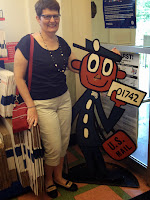Access to smart phones is not the problem. USA Today reports that even in poorer school districts, the students have phones. Where challenges come in is with the infrastructure to support the smart phone use. According to the US Department of Education, only 20 percent of the country has the infrastructure to support digital learning. What a sad statistic! Wouldn't it make more sense for the learning environments to be the first ones to have the equipment needed to teach the language of the future?
Educators and school districts also face the balance of being cutting edge vs. playing catch up. Our education department wanted iPads when they first were being used in the schools. At the time it was seen as frivolous, like they wanted the 'new toys' vs. serious equipment. Yet already students in our elementary schools are using tablets and prospective teachers need to know how to teach with them.
There is greater expectation for people to have mobile technology. Instead of fighting it, we should embrace the fact that the majority of people own more computing power than the first rocket. Students like those below are going to expect it.
-- beth triplett
leadershipdots.blogspot.com
leadershipdots.blogspot.com
@leadershipdots
leadershipdots@gmail.com
leadershipdots@gmail.com
Source: BYOT: Bring your own tech to school by Josh Higgins, USA Today, August 8, 2013




